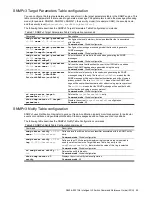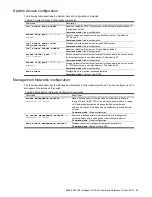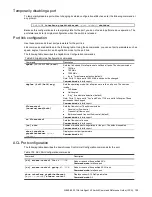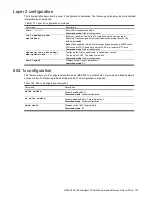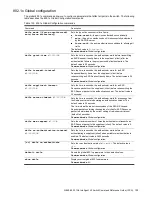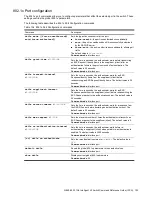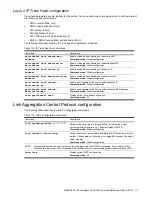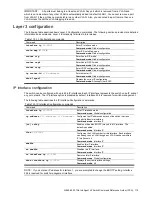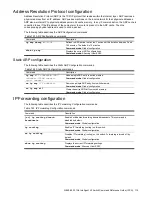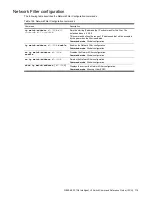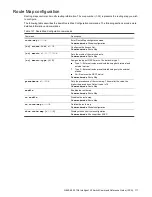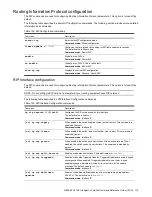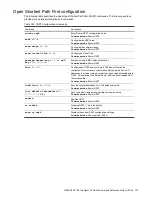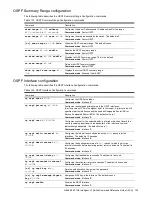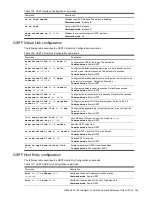
N8406-023 1Gb Intelligent L3 Switch Command Reference Guide (ISCLI) 109
Spanning Tree port configuration
By default for STP/PVST+, Spanning tree is turned Off for downlink ports (1-16), and turned On for cross-connect
ports (17-18), and uplink ports (20-24). By default for RSTP/MSTP, Spanning tree is turned Off for all downlink
ports (1-16) configured as Edge ports, and turned On for cross-connect ports (17-18) and all uplink ports (20-24).
Spanning tree port parameters are used to modify STP operation on an individual port basis. STP port parameters
include:
Port priority
Port path cost
The following table describes the Spanning Tree Port Configuration commands.
Table 111 Spanning Tree Port Configuration commands
Command
Description
spanning-tree stp
<
1-128
>
priority
<
0-255
>
Configures the port priority. The port priority helps determine
which bridge port becomes the designated port.
In a network topology that has multiple bridge ports connected
to a single segment, the port with the lowest port priority
becomes the designated port for the segment.
The range is 0 to 255, and the default is 128.
RSTP/MSTP: The range is 0 to 240, in steps of 16 (0, 16, 32...)
and the default is 128.
Command mode
: Interface port
spanning-tree stp
<
1-128
>
path-cost
<
0-200000000
>
Configures the port path cost. The port path cost is used to help
determine the designated port for a segment. Generally
speaking, the faster the port, the lower the path cost.
The range is 0 to 65535. The default is 4 for Gigabit ports
except Port 19. A value of 0 indicates that the default cost will
be computed for an auto-negotiated link speed. The default cost
is 19 for 100Mb/s ports and 4 for Gigabit ports.
RSTP/MSTP: The range is 0
– 200000000, and the default is
20000 for Gigabit ports except Port 19.
Command mode
: Interface port
spanning-tree stp
<
1-128
>
link
{auto|p2p|shared}
Defines the type of link connected to the port, as follows:
auto: Configures the port to detect the link type, and
automatically match its settings.
p2p: Configures the port for Point-To-Point protocol.
shared: Configures the port to connect to a shared medium
(usually a hub).
This command only applies when RSTP is turned on. See the
―Common Internal Spanning Tree configuration‖ section for
more information.
Command mode
: Interface port
[no] spanning-tree stp
<
1-128
>
edge
Enables or disables this port as an edge port. An edge port is
not connected to a bridge, and can begin forwarding traffic as
soon as the link is up. Configure server ports as edge ports
(enabled). By default, Ports 1-16 are configured as edge ports.
This command only applies when RSTP is turned on. See the
―Common Internal Spanning Tree configuration‖ section for
more information.
Command mode
: Interface port
[no] spanning-tree stp
<
1-128
>
fastforward
Enables or disables Port Fast Forward on the port. The default
is disabled.
Command mode
: Interface port
spanning-tree stp
<
1-128
>
enable
Enables STP on the port. This is the default for Ports 17-18 and
20-24.
Command mode
: Interface port
no spanning-tree stp
<
1-128
>
enable
Disables STP on the port.
Command mode
: Interface port

